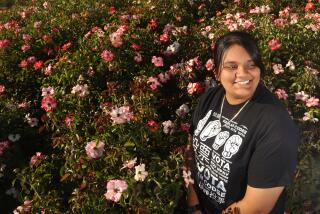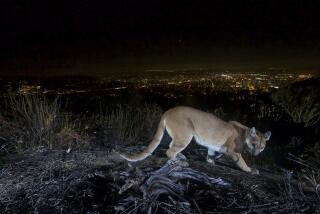Raymond F. Dasmann, 83; a Founding Father of Environmentalism
Raymond F. Dasmann, whose research and writings about threats to the natural world helped mold the modern environmental movement, died of pneumonia Tuesday in Santa Cruz. He was 83 and had been in declining health for several years.
Dasmann was a UC Berkeley-trained field biologist who began talking about the need for environmental conservation in the late 1950s, almost two decades before the concept took hold in the American mainstream.
Although not a household name like Rachel Carson or Jacques Cousteau, he is considered a luminary of environmentalism whose intellectual contributions include the concept of âecodevelopment,â or sustainable development, the idea that a communityâs progress should not rely on exploitation of its natural resources.
âHe was one of the great pioneers in trying to keep the human environment habitable and sustainable,â Paul R. Ehrlich, a Stanford University biologist and author of the landmark 1968 book âThe Population Bombâ who considered Dasmann one of his heroes, said Friday.
The author of more than a dozen books that include two classics of the conservation movement, Dasmann was respected for his global vision and insistence that ecological solutions include a central role for indigenous cultures.
His 1965 book âThe Destruction of Californiaâ was a call to action that became a staple of university ecology courses in the 1970s. Coming three years after Carsonâs âSilent Spring,â it was, said Ehrlich, âa pioneering monument in what was soon to be an explosionâ of books on ecology.
Although in frail health, Dasmann produced two memoirs in his last few years: a 232-page oral history published by the University of California Press last year; and âCalled by the Wild: The Autobiography of a Conservationist,â published in April.
He also wrote a highly regarded textbook, âEnvironmental Conservation,â originally issued in 1959 and now in its fifth edition.
Dasmann coined what he called the first law of the environment. âNo matter how bad you think things are,â he often said, âthe total reality is much worse.â
Dasmann was born in working-class San Francisco, the son of a police sergeant. His brother worked for the state Department of Forestry and helped spark Dasmannâs interest in the natural world.
He was an undergraduate at UC Berkeley when World War II erupted, sending him into the Army and service in Australia and New Guinea. During the war, he met Australian painter Elizabeth Sheldon, to whom he was married for 52 years, until her death in 1996.
He resumed his education after the war, eventually earning his bachelorâs, masterâs and doctoral degrees from UC Berkeley, where he studied under the eminent wildlife biologist A. Starker Leopold.
As a graduate student, Dasmann studied deer populations in Northern California, a topic that acquainted him with the complexities of environmental politics. Finding that the population of deer was growing far faster than their range could support, Dasmann and his colleagues argued that a doe hunt was necessary to restore balance. But they failed to convince deer hunters, who feared it would lead to extinction and ruin their sport.
Dasmann received his doctorate in 1954, then taught at Humboldt State University and later UC Berkeley. In between, he studied African wild game as a Fulbright field biologist in what was is now Zimbabwe.
In 1966, Dasmann entered the policy arena, first as an ecologist for the Conservation Foundation in Washington, D.C., then, beginning in 1970, for the International Union for Conservation of Nature in Switzerland.
He began studying environmental issues from a global vantage point, traveling to hot spots in Africa, Sri Lanka and the Caribbean.
âHe was one of the few American scientists ... and practically the only one of his generation, to look globally and locallyâ at environmental issues, said Randall Jarrell, who directs the Regional History Project at UC Santa Cruz and interviewed Dasmann for the oral history.
Dasmann returned to California in 1977 to teach ecology at UC Santa Cruz. He was an active professor until his retirement in 1989.
Jarrell, who called Dasmann the Darwin of the ecological movement, said Dasmann insisted that ecologists learn from the indigenous peoples living in threatened environments.
âIn a national park, the first thing we do is get rid of the people,â Jarrell said. âHe said, âThese people have been living here for thousands of years; letâs let them be the stewards.â His inclusion of human beings into this equation of conservation biology is one of his greatest contributions.â
Dasmannâs overriding message remained constant over the last three decades.
âI believe we must restore the sense of individual responsibility and involvement, and get away from the idea that conservation is the responsibility of somebody else -- the federal government, the state, the corporations, the rich,â he told Whole Earth magazine last year. âWe need to look at our patterns of consumption and behavior and shed those practices that contribute to the destruction of nature. This is incredibly difficult to do in a society oriented toward consumption, material enrichment and waste.â
He once built his own house -- a humble structure in the foothills of the Sierra -- but he was the first to admit that he was no paragon of conservation; he confessed, for instance, that he drove a gas-powered car.
He characterized himself as âa tentative optimistâ about the future of the world who found hope in the success of organic farming and related movements. But in his last days, the pessimist may have been winning the battle.
Bill Allayaud, legislative director of the Sierra Club in California, met him by chance a few days before his death while visiting his mother in the same nursing home. He told Dasmann that he worked for the Sierra Club and that the group was waging difficult battles.
âHe said, âSo many struggles, so many struggles,â and began to cry,â recalled Allayaud. âIt was hitting him ... the really long, hard road we have to fight. I told him, âI know why youâre crying.â I said, âWe will continue to fight.â â
Dasmann is survived by three daughters, Marlene and Sandra Dasmann of Santa Cruz and Lauren Chamberlain of Tucson; five grandchildren; and one great-grandchild.
More to Read
Sign up for Essential California
The most important California stories and recommendations in your inbox every morning.
You may occasionally receive promotional content from the Los Angeles Times.











